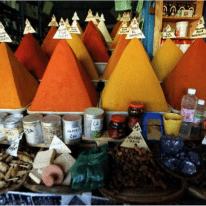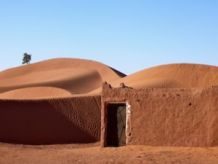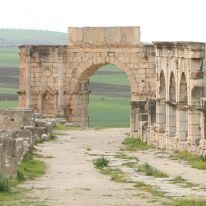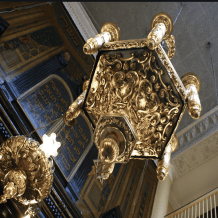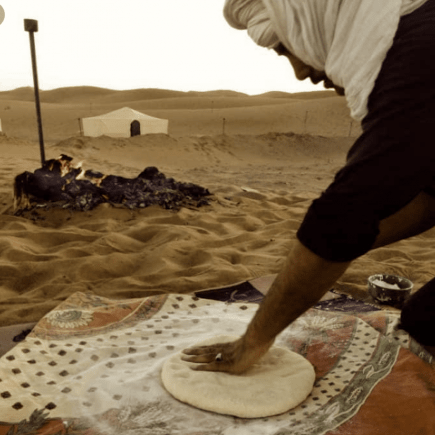
Morocco has a love affair with bread and what better a way to discover a wide range of delicious Moroccan bread then on a private, tailor-made tour. There are plenty of things you will not find on a typical Moroccan table such as silverware, water glasses, and individual plates. However there’s one thing you will always find, and that is a hearty basket of bread. As age-old Moroccan proverbs illustrate, Moroccan bread is a vital part of the diet and culture. Morocco’s terrain is dry and the land is harsh geographically. Bread is the one food that binds people together at a meal and can be made relatively inexpensively with few ingredients. Wheat can be kept and used over time when fresh ingredients are more difficult to come by. Dry bread provides sustenance for a population that today still remains semi-nomadic.
Morocco has a love affair with bread.
Visit any village in Morocco during your private tour during the wheat harvest season and you will see women in colorful attire across the fields sifting kernels of wheat in woven baskets, removing the bits that are inedible before grinding to flour. Families work together in unison within the fields collecting the grain. Not a single kernel is wasted. The grain is sold and traded among families across rural regions as well as being kept until the next harvest. Moroccan bread is a prized food.
In urban areas of Morocco where there are no family plots to tend Moroccans make bread in their home or purchase ready-made bread. The varieties of bread that Moroccan families can purchase are many ranging from typical white to grain, sesame with anise and barley. As a result of Moroccan subsidies bread is affordable to all.
How Bread Is Made Across Morocco:
Across Morocco, there are several ways of making Moroccan bread and also many varieties of preparation. In the Sahara Desert region, the traditional way of baking is to build a hot fire on top of the sand and then bury the bread once it is hot enough. You can explore making sand bread on a Sahara Desert Safari Tour.
Another Southern bread baking tradition indigenous to the Draa Valley, Saghro region is to bake bread stuffed with fat, spices and herbs directly on volcanic rock, which produces a pizza-like thick doughy bread called bourafin. In the mountains an oven resembling a tandoori oven is used, the dough stuck to the sides of the clay oven and baked over fire to produce a charred loaf of tafernout.
In the north of Morocco kalinti is a bread made with chickpea flour. There are also several iterations of stovetop bread like msemmen, harsha, and batbout. In Moroccan cities, the practice of bread baking is gradually dying out as the result of ready-made bread and a generation of new working class that has no time to bake. Bringing the daily bread (khobz) to the traditional oven was once a central part of life.
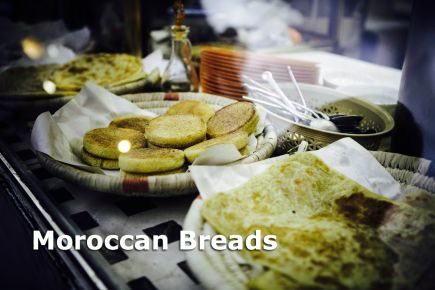
How Bread Was Made in Traditional Moroccan Homes:
In traditional Moroccan homes, women kneed their dough in the morning; flattening it into characteristic round loaves and covering it with a cotton cloth. Then, they placed it onto a tray or wooden board and either give it to one of their children to drop off on the way to school or leave it outside the door. A neighbor or another person passing by who saw the tray instinctively pick it up and drops it off at the oven. At lunch, it was picked up and paid for, each loaf a flat rate. In the ovens, dozens of loaves at a time are baked. The baker always knew which bread belongs to which tray and family. The baker was also the eyes and ears of the community through his close, daily interaction with the neighbors. He could tell how well off a family was, how often they had company, and more based on passing words when coming in or the bread itself. When the engagement was in the works, the baker was often consulted for inside information on the prospective bride or groom’s family.
Bread is the utensil used to eat. It’s broken off (never cut with a knife) and used to scoop up tajines, soak up sauces, and savory soups. It’s drizzled with olive oil and served alongside a hot cup of tea for breakfast or stuffed with tuna or boiled eggs for a snack or late night meal. When there’s little else in the cupboards there’s bread to tide over an empty stomach.
Bread is held in very high esteem in Morocco. It is never thrown in the garbage and the first reaction when dropped on the floor is to immediately pick it up and kiss it. The very basic ingredients in Moroccan bread mean that within a day or at most two it is dry. Dishes like treda make use of bread that’s stale. It’s shredded and put in the bottom of a plate and then topped with spiced lentils, sauce, and chicken if available.
To dispose of bread scraps that cannot be salvaged the garbage is not an option. They’re put in a bag separate from the other waste and when collected set aside by the garbage man. It’s then fed to animals or used as compost.
The sacredness and special place bread hold in the Moroccan culture and home is not without challenges. Those who struggle with illnesses like celiac disease face an uphill battle. For many Moroccans, it’s unfathomable that bread could make someone violently ill. For visitors, this can be a difficult bridge to cross.
Every culture has a particular food item that serves as a staple and the Moroccan love affair with bread remains a steadfast part of the Moroccan culinary tradition.
“The children of him who has wheat in his house should not beg of his neighbor.”
“Manage with bread and salted butter until God brings something to eat with it.”
“There is no hunger but the hunger of wheat.”
~ Moroccan Proverbs
For more How to Make Moroccan bread or a Tailor Made Tour
Amanda Mouttaki is a food and travel writer and blogger, with expertise on Moroccan culinary traditions and food culture. Her passion is uncovering the stories behind traditional cultures and food around the world. She lives in Marrakech, Morocco with her family.


